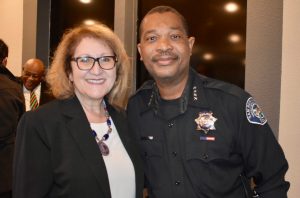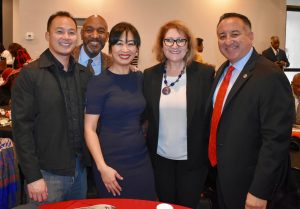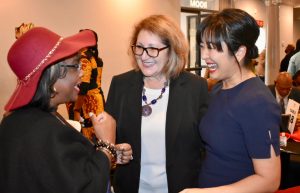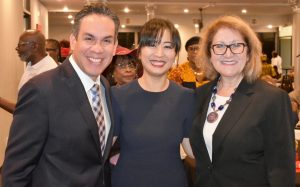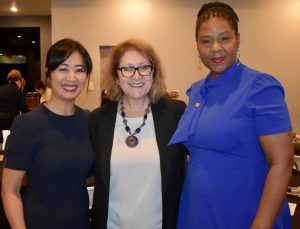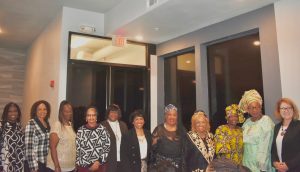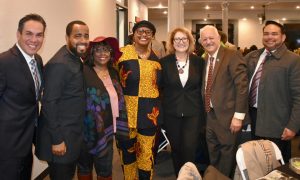NATUNA SEA—Sonar Technician (Surface) 1st Class Zachary Jacoban, from San Bernardino, California, removes chaff shells from launchers aboard Independence-class littoral combat ship USS Oakland (LCS 24) as the ship sails in the Natuna Sea, Jan. 19, 2023. Oakland, part of Destroyer Squadron 7, is on a rotational deployment operating in the U.S. 7th Fleet area of operation to enhance interoperability with partners and serve as a ready-response force in support of a free and open Indo-Pacific region.
Omnitrans CEO/GM Named Woman of the Year
SAN BERNARDINO, CA—- Omnitrans CEO/General Manager Erin Rogers has been named “Woman of the Year” by the Women’s Transportation Seminar (WTS) –Inland Empire chapter.
“It is an honor to be acknowledged for my work in the industry I have dedicated my career to and have Omnitrans recognized for the strategic and important work the agency is doing,” said Rogers.
“I am proud of Omnitrans’ initiatives to connect our community, and of our team.”
Rogers was nominated and selected by WTS member voting for her leadership in transit service innovation and effectiveness, and her development of women in key roles. Omnitrans’ senior leadership team is 50 percent female, including the agency’s first female director of maintenance. The agency also partners with WTS on events such Classroom to Career days to expose students to professional possibilities in the industry and build the next generation of transit leaders.
WTS’s mission is to attract, sustain, connect, and advance women’s careers to strengthen the transportation industry. “[Rogers] is inspirational,” said WTS Inland Empire Chapter President Stephanie Blanco.
Upcoming Event: 30th Annual Black Rose Awards Banquet
SAN BERNARDINO, CA— The San Bernardino Black Culture Foundation’s 30th Black Rise Awards winners will be recognized at the annual banquet on Saturday, February 4 from 6 p.m. to 9 p.m. at the California State University, San Bernardino Santos Manuel Statdium located at 5500 University Parkway.
In remembrance of Dr. Margret Hill, the Black Culture foundation has renamed its Margret Hill Community Support Award to the Dr. Margret Hill Black Rose Young Adults Inspiration Award. This award will present scholarships to two inspirational and outstanding San Bernardino Black young adults graduating grade 12 or in college.
“This year’s Award Gala is held to commemorate Rosa Parks’ birthday,” said Black Rose Committee Co-Chair, Jim King.
The San Bernardino Black Culture Foundation is a 501(c)3 non-profit organization, founded in 1986 to honor and share the richness of our Black heritage, to recognize world diversity and inspire our youth/young adults toward leadership, providing scholarships and career opportunities.
Individual tickets are $75 each. Tables are also available for $600. For more information ob becoming a sponsor or to purchase tickets, go to www.evenbrite.com/e/30th-black-rose-awards-banquet-tickets-491089169927
San Bernardino Mayor Helen Tran Calls for the City to Declare a Homeless State of Emergency
SAN BERNARDINO, CA—- With a recently approved Homeless Action Plan in place and a commitment to spend over $20 million on a solution, San Bernardino leaders on February 1st will discuss declaring a Homeless State of Emergency. San Bernardino would join Los Angeles, Long Beach, and Los Angeles County in declaring such an emergency.
“We want to make it clear to our residents that addressing homelessness is San Bernardino’s priority number one,” said Mayor Helen Tran. “We must focus our efforts, implement our plan, and demand nothing less than better results.”
By declaring a homeless emergency, the San Bernardino can set policies to accelerate the implementation of its recently approved Homeless Action Plan. In addition, the city will be setting up a Homeless Task Force, made up of City leaders, department heads, service providers and advocates that will meet regularly to monitor the Action Plan’s progress.
At a Council workshop in November, City staff presented a comprehensive Homeless Action Plan that detailed multiple initiatives to enhance what is called the continuum of care, which includes prevention, outreach, emergency shelters, drug and mental health care, transitional housing, and affordable housing. Last month, the Council approved spending over $20 million it received from the American Rescue Plan Act to fund the Plan.
The Action Plan includes spending $12.4 million to construct a homeless navigation center. The navigation center would operate as a centralized point of individualized supportive services, including case management, housing assistance, mailbox services, job placement, substance abuse recovery, and health services. The facility would also include up to 100 short term housing units, possibly in the form of prefabricated “tiny homes.” With additional funding, the navigation center could be expanded to up to 200 units.
The City has also budgeted $1.5 million to create a homeless outreach team. Outreach team members will regularly engage with San Bernardino homeless to build trust and provide resources in the field. In most cases, it takes multiple contacts, sometimes dozens, before a homeless individual is willing to consider accepting assistance. In addition to the outreach, the city is considering purchasing a homeless management information system that can network outreach staff with City’s partners so an inventory of available beds, service appointments, and other resources are available in real time.
San Bernardino will partner with San Bernardino Valley Community College (SBVCC) and Lutheran Social Services to develop new housing projects. The SBVCC project, at a cost to the City of $900,000 will be located near the campus and house up to 60 students who are homeless or at risk of becoming homeless. The Lutheran Social Services, at a cost of $5 million, will consist of up to 200 units and provide additional services to its residents.
The Council also approved adding twelve additional staff in the Public Works Department to significantly increase city wide cleanups, including homeless encampments, and $150,000 for a mobile shower and laundry.
With homelessness a problem throughout California, the city will be seeking additional funding to fully implement the Homeless Action Plan through grants and programs recently launched by the State, as well as continuing to work with non-profits, health care providers, and the County.
“A solution will take the skills and resources of many partners,” said Tran. “Our emergency declaration makes it clear that San Bernardino, its leadership, its staff, and its residents, are beyond our limit for what we are willing to accept. We are committed to addressing homelessness.”
The Lunar New Year: Treasuring an Asian American California Tradition
By Jaivon Grant | California Black Media
Although it is celebrated in many countries around the world like Korea, Malaysia, Singapore, Taiwan and Vietnam, the Lunar New Year is widely recognized as an important social and economic holiday — in China and places with significant Chinese populations.
In the Golden State, people of Chinese descent comprise 23% of all Asians and that sub-group in aggregate accounts for about 20% (5.8 million people) of the state’s population.
In Los Angeles, there are nearly 678,000 Chinese immigrants (not counting Chinese Americans who are second-generation Americans and beyond.)
Mei Mei Huff is the Executive Director of the ACT Against Hate Alliance (AAHA), a Los Angeles-based organization that is working to eliminate hate by targeting its root causes.
According to Huff, the Lunar New Year is a time when families get together and celebrate traditions over a warm dinner and fond memories.
“People get together to have family reunions and dinner. While different areas prepare different dishes to celebrate New Year, the sumptuous meal will include different kinds of meat, fresh vegetables, different seafood, dumplings, rice cakes, etc., and each item is designed to bring prosperity and abundance to our family members,” Huff said. “It is truly an important day in Eastern cultures, and it’s about celebrating the most meaningful things to you.”
The Lunar New Year, also referred to as the Spring Festival, signifies the arrival of spring and the start of a new year on the lunisolar calendar (based on the positions of the moon and sun).
The 2023 Lunar New Year begins on January 22 and traditionally the celebration runs for 15 days.
“Each year, the Lunar calendar is represented by one of 12 zodiac animals included in the cycle of 12 stations or ‘signs’ along the apparent path of the sun through the cosmos,” according to History.com.
The 12 zodiac animals are the rat, ox, tiger, rabbit, dragon, snake, horse, sheep, monkey, rooster, dog and pig.
2023 is the year of the Rabbit.
In addition to the animals, five elements — earth, water, fire, wood and metal — are also mapped onto the traditional lunar calendar. Each year is associated with an animal that corresponds to an element.”
The Chinese New Year is thought to have originated in the Shang Dynasty in the 14th century B.C., but its exact start day is unknown. It serves as a time for grand feasts to honor heavenly deities and ancestors. Hundreds of millions of people travel worldwide to go home and celebrate with their families.
Huff says fish is usually eaten as the last course of the Lunar New Year’s Eve meal to symbolize good luck. In the Chinese language, the pronunciation for “fish” is the same as the word for “abundance” or “surplus.” Because of this, the fish will not be totally eaten to signify that there will be surplus in the year to come.
Families frequently prepare for the Lunar New Year by thoroughly cleaning their houses, which represents ridding the area of evil spirits and opening space for good will and fortune.
“We would wear new clothes, and my father would light fireworks to ward off any evil spirits or demons around the house,” said Huff. “It’s a tradition to dispel all the demons and monsters to bring peace and health to the family.”
Some other traditions include elders giving out red envelopes that contain money to children. Red-paper couplets, intricate red paper-cut art, and red posters decorated with calligraphy messages of good health and fortune are placed on the doors, windows and around the homes.
Hongxia Xiao — going by the American name Sammie – is a San Francisco resident who immigrated from China more than 10 years ago. She says, since moving to the United States, she still cherishes the Lunar New Year traditions.
“No matter where I am, I will always celebrate the [Chinese] New Year,” said Sammie. “It represents getting rid of the old and bad, and bringing in the new.” She also celebrates by having leftover fish symbolizing that one will have a surplus in money, luck, love, and fortune in life.
San Francisco is reported to have the biggest Lunar New Year parade outside of Asia. It is a tradition that began during the Gold Rush era in the 1860s, when an influx of Chinese citizens immigrated to that region of the state.
The Lunar New Year celebration concludes with the Lantern Festival, which includes parades, dancing, games, and fireworks.
This California Black Media feature was supported in whole or in part by funding provided by the State of California, administered by the California State Library.
Caution and Equity Are Hallmarks of Gov. Newsom’s First Budget Under Black Director
By Aldon Thomas Stiles | California Black Media
On Tuesday January 10, at a press conference held in Sacramento, Gov. Gavin Newsom presented his first draft of the state’s 2023-2024 budget to the Legislature.
The proposal, which totaled $223.6 billion, is the first spending plan developed under the supervision of Joe Stephenshaw, the first Black director of the California Department of Finance. The state’s budget for the next fiscal year presents a more modest outlook than last year’s, which totaled $240 billion.
In his presentation, Newsom assured Californians that the state has $35.6 billion in reserves, which the governor says he intends not to touch.
Stephenshaw, who took the podium after the governor, explained that the decrease in the budget and the decision not to tap into the reserves are not actions taken in anticipation of an impending recession.
Instead, he said, the state is practicing “moderation” due to witnessing “slower growth” revenues than was expected last year.
An assessment of Newsom’s budget proposal by the independent Legislative Analyst’s Office (LAO) determined that a recession is not an unlikely possibility and praised the proposed budget for making financial sense.
“Notably, the Governor does not propose using any reserves,” LAO’s statement read. “This approach is prudent given the downside risk to revenues posed by the current heightened risk of recession.
The statement also cautioned lawmakers.
“We recommend the Legislature maintain this approach during its own planning process,” the statement continued.
Sen. Steve Bradford (D-Gardena), vice chair of the California Legislative Black Caucus (CLBC) said the state’s more cautious spending plan for the next fiscal year is a “step in the right direction” but promised to continue to fight to fund priorities that are critical for California’s most “marginalized” and “vulnerable” communities.
“As many Californians are struggling to pay for groceries, housing, and gas, the state faces its own money concerns. A projected budget shortfall of about $24 billion will challenge the Legislature and the Governor to ensure our investments will provide services to those Californians who need them the most,” he observed.
“I look forward to the budget process and will work to make sure any adjustments to investments in jobs, healthcare, education and public safety are viewed under a lens of equity,” Bradford added.
Some observers praised the Newsom’s draft budget because it did not come with new taxes.
“I was pleased to see that taxes are not part of the new state budget,” Assemblymember James C. Ramos (D-Highland)
said in a statement released by his office on the day of the announcement.
“Even though California faces a budget deficit, we will continue moving forward to improve education, reduce homelessness, and combat fentanyl use, especially among our children and youth to ensure public safety and economic development in the face of threats from flooding, wildfires, drought, and other climate extremes,” Ramos promised.
The budget proposal focuses heavily on education, with provisions for public schools, colleges, universities and other academic support, accounting for about 46% of the general fund.
About 36.3% is allotted to K-12 education and 10.1% is earmarked for higher education.
Chair of the CLBC Lori Wilson (D-Suisun City) praised Newsom for specifically committing $300 million to K-12 education to close the academic achievement gap of low-income students.
“Thank you, Governor @GavinNewsom for including this funding in the budget and shout out to my colleague Asm. Akilah Weber, MD, for her tireless work on this issue,” Wilson tweeted.
Some Republican lawmakers issued brisk criticisms of Newsom’s spending plan and Democrats’ endorsement of it.
“Democrat politicians have wasted a record surplus on new social programs and pork projects, while allowing our aging infrastructure to crumble. Now, we are faced with a $22 billion deficit as a result of their fiscal recklessness. It’s high time we refocus our budget on the core functions of government,” said Assembly Republican Leader James Gallagher (D-Yuba City).
“As California bounces between flooding and drought, it is abundantly clear that we need new water storage, and yet there is still no dedicated funding this year or next to meet that need. Instead, the Governor protects failed programs that haven’t made a dent our state’s highest-in-the-nation poverty rate.”
In his presentation, Newsom evoked Proposition 98 which requires a minimum funding level for community colleges and other schools.
After education, the second-highest funded priority is health services and initiatives at 23.4% of total spending.
If the Legislature approves, some of the monies for health funding will go toward mental health for programs like CARE Court and CalAim.
There are also funds dedicated to reproductive care.
In a statement, Planned Parenthood Affiliates of California stood behind the governor’s decision.
“Maintaining and pursuing new investments is critical in the pursuit of accessibility and equity for California patients and those forced to seek care here,” the statement read.
Another 8.6% of the budget will go toward human services, 4.3% will go to natural resources, and 10.7% will go to other efforts.
“With our state and nation facing economic headwinds, this budget keeps the state on solid economic footing while continuing to invest in Californians,” said Newsom.
Assemblymember Tina McKinnor (D-Inglewood) – also a member of the CLBC – expressed her support on Twitter.
“Governor Newsom’s proposed 2023-24 state budget preserves a lot of the progress we’ve made over the past few years and helps navigate short term fiscal issues while maintaining our long-term vision for CA,” she tweeted.
During the press conference, Newsom indicated that he believes continued investments in things like universal healthcare will bring about radical change for the state.
Over the next five months, the Governor and the Legislature will work to hash out their differences and present an updated draft proposal, commonly known as the “May Revise.”
By law, Legislators have until June 15 to approve the final budget, which takes effect July 1.
Stormy Winter: California Takes Steps to Manage Impact of Weather and Water
By Aldon Thomas Stiles| California Black Media
Over the last few weeks storms have torn through many of California’s communities, prompting evacuations in areas like Planada and Merced due to widespread flooding.
There have been at least 19 fatalities due to storm related incidents, according to the Governor’s Office of Emergency Services.
Friday, January13, marked the end of the seventh storm and beginning of the eighth storm in a series of nine storms.
That day, Gov. Newsom paid a visit to Santa Barbara, joining first responders, volunteers, and members of Cal Guard as they filled sandbags in preparation for the storm to come.
“The magnitude of this is not isolated to smaller communities, it is scaled across the largest state in our union,” Newsom said at a press conference held in Santa Barbara.
Newsom said that Californians can expect these storms to continue through at least the 18th of this month.
But what does this mean for the state’s long-standing drought?
Since 2019, California has been experiencing its driest period in 1,200 years, according to a study published by Nature Climate Change.
Molly White, the State Water Project’s Water Operations Manager, says that the statewide reservoir storage sits at 87% of the historical average, surpassing the 2021 and 2022 levels.
“We’re certainly, across the state, seeing an increase in storage with this storm activity,” White said during a presentation hosted by the California Department of Water Resources (DWR).
However, there are variations in water storage from county to county.
This has much to do with how areas get their water supply as some areas rely on groundwater – which usually accounts for about 30% to 60% of the state’s total water supply, depending on the year; others rely more heavily on surface storage.
Tim Godwin, DWR Supervising Engineering Geologist at the Sustainable Groundwater Management Office, talked about how the framework for groundwater storage is outlined in the Sustainable Groundwater Management Act (SGMA).
Signed in 2014, SGMA was conceived to protect water present below the earth’s surface by requiring local agencies to form groundwater sustainability agencies to manage water in their respective regions.
“Groundwater is best managed locally,” Godwin said during the online presentation. “It also acknowledges that groundwater and surface water are intimately connected.”
The Flood Operations Center (FOC) has identified six focus areas critical in the flood prevention effort: the Pajaro River in Santa Cruz and Monterey County, the Salinas River in Monterey County, the Cosumnes River in Sacramento County, Bear Creek River in Merced County, the Russian River in Mendocino and Sonoma County, and the State-Federal Flood Control system in Sacramento and the San Joaquin Valleys.
Even when the storms slow, state officials claim that water levels will remain high due to the fluctuations in some of these target areas.
On Jan. 14, President Joe Biden approved the state’s emergency declaration, making federal funding available for Merced, Sacramento, and Santa Cruz.
Additionally, Newsom proposed $202 million in flood prevention in the 2023-2024 budget proposal.
Newsom claimed that these storms – and other tumultuous weather conditions are not happenstance, but a symptom of climate change.
“Megadroughts. Wildfires. Historic floods and atmospheric rivers. This whiplash weather is not an anomaly. California is proof that the climate crisis is real, and we have to take it seriously,” Newsom tweeted.
Newsom commended those who have been at the front line of these treacherous storms.
“I couldn’t be more proud of the first responders and everyday Californians stepping up across the state to help support communities impacted by these ongoing storms,” Newsom said in a statement. “With more difficult days ahead, it’s critical that Californians stay alert to conditions in their area and follow guidance from local emergency responders to stay safe.”
Photo Recap: 43rd Annual Martin Luther King, Jr., Prayer Breakfast
SAN BERNARDINO, CA— On Monday, January 16, 2023, the Inland Empire Concerned African American Churches hosted their 43rd Annual Martin Luther King Jr. Prayer Breakfast. The community thanks Bishop Kevin Simmons and IECAAC for their leadership and dedication to the community throughout the years.
Los Angeles Urban League Appoints Cynthia Mitchell Heard as Its New Chief Operating Officer
The highly respected non-profit executive makes history by becoming the first woman Chief
LOS ANGELES, CA—- Cynthia Mitchell Heard, a highly respected leader in nonprofit, has joined the Los Angeles Urban League (LAUL) as its Chief Operating Officer (COO). The announcement was made by Ambassador Michael A. Lawson, President and CEO of the perennial civil rights organization. The appointment is a historic one for the iconic organization, with Ms. Heard becoming the first woman to hold this leadership position at LAUL.
“We are excited to have Cynthia Heard as our new Chief Operating Officer,” said Ambassador
Lawson. “Ms. Heard has an extensive background and experience in the non-profit world and her accomplishments in bettering the lives of disenfranchised communities in Los Angeles are admirable and remarkable. We are looking forward to her leadership as we move the Los Angeles Urban League into its second 100 years of service.”
Cynthia Mitchell Heard previously served as Vice President of Business Development and Communications for the YWCA Greater Los Angeles (YWCA, GLA), creating and helming unprecedented social impact campaigns which serve as a blueprint for systemic change. Ms. Heard created a myriad of public/private, state, local and federal partnerships to design innovative community and operational collaborations throughout Los Angeles County to fund supportive services. During the COVID 19 pandemic, she developed key funding mechanisms through her steadfast efforts and assisted with promoting economic stability through public private workforce development, community engagement and securing resources to improve disenfranchised communities that experienced lack of access.
Prior, Ms. Heard served as Senior Executive Vice President of Programs for Children Uniting Nations (CUN) where she developed national collaborative stakeholder partnerships and created statewide bi-partisan advocacy initiatives that focused on new avenues to break down the barriers that surround at-risk/foster youth and marginalized families.
“It is my honor to join President & CEO, Michael Lawson, and the entire team at the Los Angeles Urban League,” said Cynthia Heard. “I am truly looking forward to embracing the mission of LAUL and the commitment of this stellar team as we continue the advancement of the ongoing community engagement programs, economic stability/self-reliance, civil rights advocacy and the workforce enrichment of our marginalized and disenfranchised communities throughout Los Angeles.”
“Living the Dream” San Bernardino Martin Luther King Parade and Extravaganza
By Aryana Noroozi
This Martin Luther King Jr. Day, the city of San Bernardino gathered at “Living the Dream,” a Martin Luther King Parade and Extravaganza sponsored by the Southern California Black Chamber of Commerce and hosted in West San Bernardino. The event held space for the community to watch performances, hear from elected officials and explore vendor booths.
Highlights of the day included a performance from the Grammy nominated group hailing from Rialto, J.J. Fad, and an inspiring message to the community from newly elected Mayor Helen Tran.
“[MLK] never led alone. He led with community. And that is what I will do as your newly elected mayor, show that we lead together and that we lead with truth, light, and unity, because we deserve it,” Tran said.
Grand Marshals for the 2023 San Bernardino MLK Parade and Extravaganza were James Ramos, California State Assemblymember; Eloise Reyes, California State Assemblymember; Joe Baca, Jr., San Bernardino County Supervisor, Fifth District; Helen Tran, San Bernardino City Mayor-Elect; and our new African American Chief of Police for the City of San Bernardino Darren L Goodman.

“[MLK] never led alone. He led with community,” said newly elected Mayor Helen Tran at the Martin Luther King Parade and Extravaganza event sponsored by the Southern California Black Chamber of Commerce in San Bernardino. Credit: Aryana Noroozi, Black Voice News Newsroom/CatchLight Local

The San Bernardino PaceSetter Team drill team lines up to perform at the Martin Luther King Parade and Extravaganza at Arroyo Valley High School in San Bernardino on January 16, 2023. The event was hosted by The Southern California Black Chamber of Commerce and featured guest appearances by the region’s elected leaders, including Mayor Helen Tran and Senator Rosilicie Ochoa Bogh, and a performance by Rialto natives, J.J. Fad. (Aryana Noroozi, Black Voice News Newsroom/CatchLight Local).

The San Bernardino PaceSetter Team drill team begins their performance at the Martin Luther King Parade and Extravaganza on January 16, 2023. (Aryana Noroozi, Black Voice News Newsroom/CatchLight Local).

Rialto natives, J.J. Fad perform their hit song “Supersonic,” at the Martin Luther King Parade and Extravaganza on January 16, 2023. “Supersonic” reached #10 on Billboard Hot Dance/Club Play Songs and was nominated for a Grammy Award for Best Rap Performance in 1989, making J.J. Fad the first all-female rap group to be nominated for a Grammy award. (Aryana Noroozi, Black Voice News Newsroom/CatchLight Local).

The crowd cheers and dances to J.J. Fad’s performance at the Martin Luther King Parade and Extravaganza on January 16, 2023. (Aryana Noroozi, Black Voice News Newsroom / CatchLight Local).

The crowd watches and sings along to J.J. Fad’s performance at the Martin Luther King Parade and Extravaganza on January 16, 2023. (Aryana Noroozi, Black Voice News Newsroom / CatchLight Local).

J.J. Fad members, Juana Burns “MC J.B.” and Dana Birks “Baby D” and former NWA member, producer and rapper, Arabian Prince pose for a portrait at the Martin Luther King Parade and Extravaganza on January 16, 2023. (Aryana Noroozi, Black Voice News Newsroom / CatchLight Local).
Elected officials join the celebration

Councilwoman of San Bernardino’s Sixth Ward, Kimberly Calvin thanks the public for their service at the Martin Luther King Parade and Extravaganza on January 16, 2023. “Raise your hand if you contribute to the City of San Bernardino in any capacity, because we are here to serve you and we thank you for all that you do,” Calvin said before introducing a group of elected officials including San Bernardino Mayor Tran . (Aryana Noroozi, Black Voice News Newsroom/CatchLight Local).

Newly elected Mayor of San Bernardino County, Helen Tran, addresses the crowd at the Martin Luther King Parade and Extravaganza in San Bernardino on January 16, 2023. Tran is the first Asian mayor of San Bernardino and the first Vietnamese mayor in the nation. “What really inspired me from Reverend Dr. Martin Luther King, Jr., was that he never led alone. He led with community,” Tran said. “As your mayor I will make sure we lead together.” (Aryana Noroozi, Black Voice News Newsroom /CatchLight Local).

Councilmember Damon Alexander speaks to the crowd at the Martin Luther r. King Parade and Extravaganza in San Bernardino on January 16, 2023. Alexander is the first Black council member in the seventh ward. “Unity requires action,” Alexander said. “So I need everyone here to work in unity.” (Aryana Noroozi, Black Voice News Newsroom/CatchLight Local).

Senator Rosilicie Ochoa Bogh (right), who represents the Inland Empire, thanks the Southern California Black Chamber of Commerce for hosting the event on January 16, 2023. Senator Ochoa Bogh presented award certificates to the Southern California Black Chamber of Commerce, Dr. Martin Luther King Junior’s parade committee and YouthBuild Inland Empire. (Aryana Noroozi, Black Voice News Newsroom/CatchLight Local).

Dr. Gwendolyn Dowdy-Rodgers, a newly elected member of the San Bernardino County School Board speaks to the crowd at the Martin Luther King Parade and Extravaganza in San Bernardino on January 16, 2023. “[MLK] said togetherness, we have to learn how to live together, or together we will perish as fools,” Dr. Dowdy-Rodgers said, quoting MLK. “Today we have defied those odds. We are here together living as one.” (Aryana Noroozi, Black Voice News Newsroom /CatchLight Local).
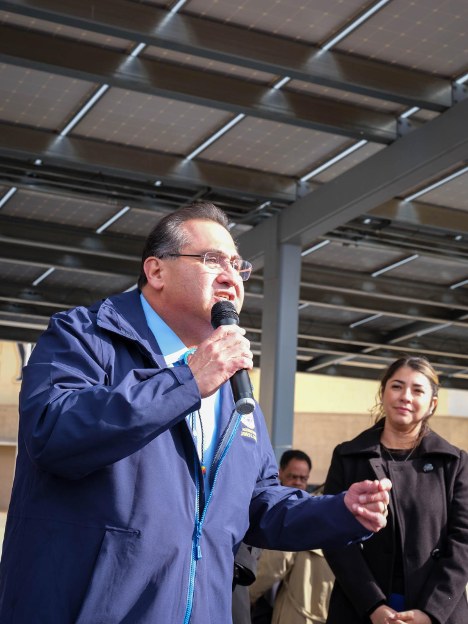
Assemblymember of the 47th District, James Ramos speaks to the crowd at the Martin Luther King Parade and Extravaganza in San Bernardino on January 16, 2023. “Look at the diversity on this stage. When I grew up, you wouldn’t see this diversity representing families,” said Ramos who grew up on San Manuel tribal lands. (Aryana Noroozi, Black Voice News Newsroom/CatchLight Local).
A community comes together in celebration
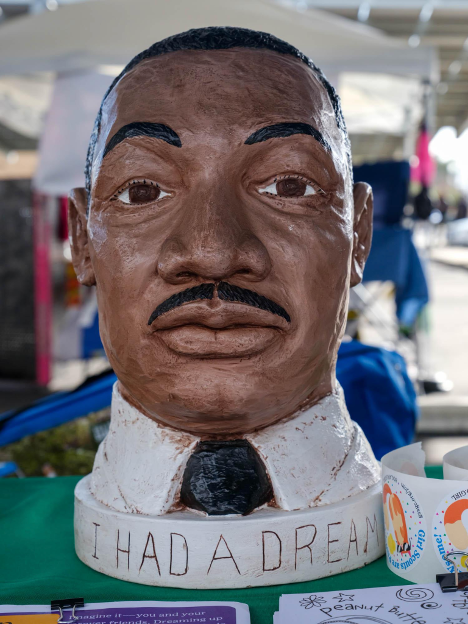
A Martin Luther King Jr. statue sits in the Girl Scouts of San Gorgonio booth at the Martin Luther King Parade and Extravaganza in San Bernardino on January 16, 2023. (Aryana Noroozi, Black Voice News Newsroom/CatchLight Local).

Ashley Dial and her daughter Imani Dial pose for a portrait at the Martin Luther King Parade and Extravaganza on January 16, 2023. (Aryana Noroozi, Black Voice News Newsroom/CatchLight Local).
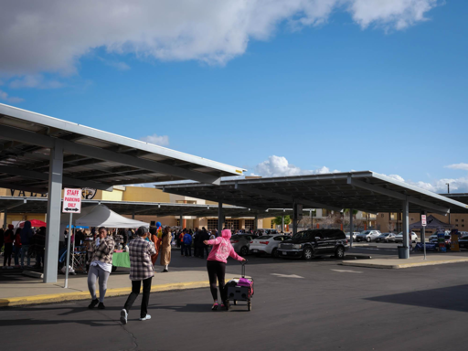
Celebration-goers walk through the parking lot of Arroyo Valley High School where the Martin Luther King Parade and Extravaganza was held on January 16, 2023. (Aryana Noroozi, Black Voice News Newsroom/CatchLight Local).
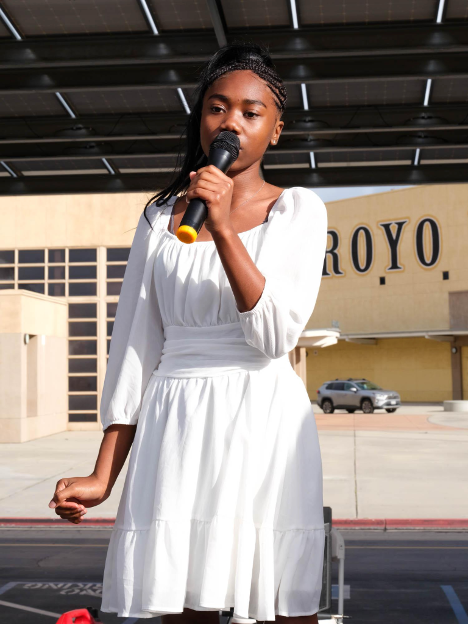
Tia Woods performs a song she wrote during the pandemic about getting through difficult times at the Martin Luther King Parade and Extravaganza on January 16, 2023. (Aryana Noroozi, Black Voice News Newsroom/CatchLight Local).

Members of the San Bernardino PaceSetter drill team pose for a photo at the Martin Luther King Parade and Extravaganza on January 16, 2023. (Aryana Noroozi, Black Voice News Newsroom/ CatchLight Local).
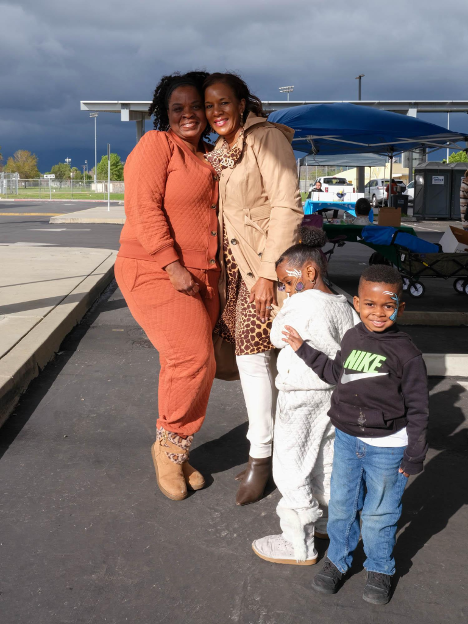
Felicia Alexander, Brigitte Kilpatrick and children, Destinee Kilpatrick and Dexter Kilpatrick pose for a portrait at the Martin Luther King Parade and Extravaganza on January 16, 2023. (Aryana Noroozi, Black Voice News Newsroom/CatchLight Local).

Dexter Kilpatrick poses for a photo taken by his sister, Destinee Kilpatrick at the Martin Luther King Parade and Extravaganza on January 16, 2023. (Aryana Noroozi, Black Voice News Newsroom/CatchLight Local).
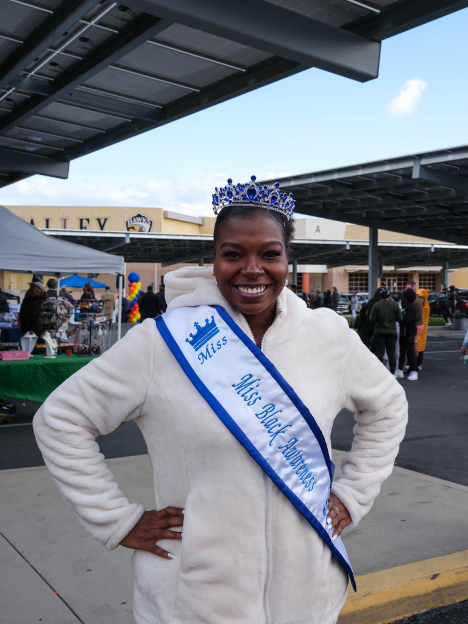
Liyah Belvins, who was named 2022-23 Miss Black Awareness in Fontana during the annual ceremony in December, poses for a portrait at the Martin Luther King Parade and Extravaganza on January 16, 2023. (Aryana Noroozi, Black Voice News Newsroom/CatchLight Local).
Collaborators for The San Bernardino MLK Day Parade and Extravaganza include: First Five San Bernardino, The Southern California Black Chamber of Commerce, Lue Productions Community Umbrella Services, Dameron Communications, YouthBuild Inland Empire, Chords Youth Enrichment Program, San Bernardino Valley College, San Bernardino Airport, Off the Chain Alliance, Westside Story Newspaper, Empire Talks Back and Black Health Coalition.
For more information go to BlackChamberofCommerce.org or call (888) 466-7408.
 Westside Story Newspaper – Online The News of The Empire – Sharing the Quest for Excellence
Westside Story Newspaper – Online The News of The Empire – Sharing the Quest for Excellence
